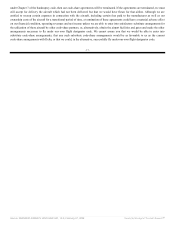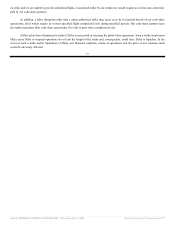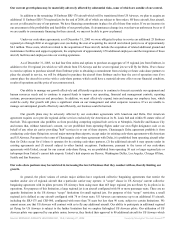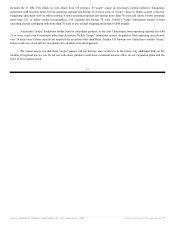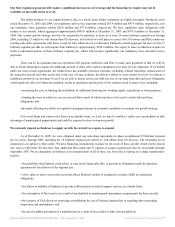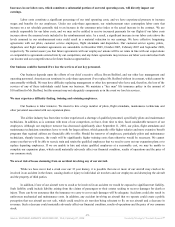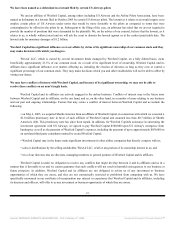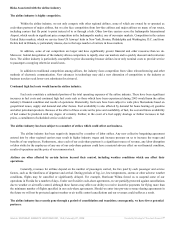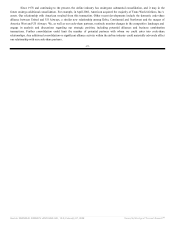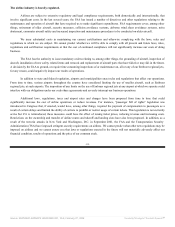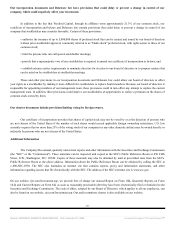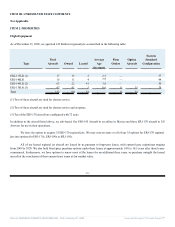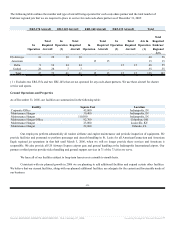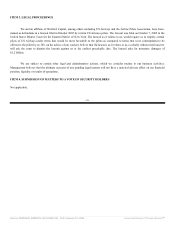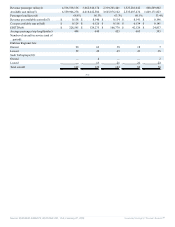Frontier Airlines 2005 Annual Report Download - page 42
Download and view the complete annual report
Please find page 42 of the 2005 Frontier Airlines annual report below. You can navigate through the pages in the report by either clicking on the pages listed below, or by using the keyword search tool below to find specific information within the annual report.
Risks Associated with the airline industry
The airline industry is highly competitive.
Within the airline industry, we not only compete with other regional airlines, some of which are owned by or operated as
code-share partners of major airlines, but we also face competition from low-fare airlines and major airlines on many of our routes,
including carriers that fly point to point instead of to or through a hub. Other low-fare carriers serve the Indianapolis International
Airport, which results in significant price competition in the Indianapolis market, one of our major markets. Competition in the eastern
United States markets, which we service from US Airways' hubs in New York, Boston, Philadelphia and Washington, D.C. and from
Delta's hub in Orlando, is particularly intense, due to the large number of carriers in those markets.
In addition, some of our competitors are larger and have significantly greater financial and other resources than we do.
Moreover, federal deregulation of the industry allows competitors to rapidly enter our markets and to quickly discount and restructure
fares. The airline industry is particularly susceptible to price discounting because airlines incur only nominal costs to provide service
to passengers occupying otherwise unsold seats.
In addition to traditional competition among airlines, the industry faces competition from video teleconferencing and other
methods of electronic communication. New advances in technology may add a new dimension of competition to the industry as
business travelers seek lower-cost substitutes for air travel.
Continued high fuel costs would harm the airline industry.
Fuel costs constitute a substantial portion of the total operating expenses of the airline industry. There have been significant
increases in fuel costs and continued high fuel costs such as those which have been experienced during 2005 would harm the airline
industry's financial condition and results of operations. Historically, fuel costs have been subject to wide price fluctuations based on
geopolitical issues, supply and demand and other factors. Fuel availability is also affected by demand for home heating oil, gasoline
and other petroleum products. Because of the effect of these events on the price and availability of fuel, the cost and future availability
of fuel cannot be predicted with any degree of certainty. Further, in the event of a fuel supply shortage or further increases in fuel
prices, a curtailment of scheduled service could result.
The airline industry has been subject to a number of strikes which could affect our business.
The airline industry has been negatively impacted by a number of labor strikes. Any new collective bargaining agreement
entered into by other regional carriers may result in higher industry wages and increase pressure on us to increase the wages and
benefits of our employees. Furthermore, since each of our code-share partners is a significant source of revenue, any labor disruption
or labor strike by the employees of any one of our code-share partners could have a material adverse effect on our financial condition,
results of operations and the price of our common stock.
Airlines are often affected by certain factors beyond their control, including weather conditions which can affect their
operations.
Generally, revenues for airlines depend on the number of passengers carried, the fare paid by each passenger and service
factors, such as the timeliness of departure and arrival. During periods of fog, ice, low temperatures, storms or other adverse weather
conditions, flights may be cancelled or significantly delayed. For example, Hurricane Wilma forced us to suspend some of our
operations in Florida for a number of days. Under our fixed-fee code-share agreements, we are partially protected against cancellations
due to weather or air traffic control, although these factors may affect our ability to receive incentive payments for flying more than
the minimum number of flights specified in our code-share agreements. Should we enter into pro-rate revenue sharing agreements in
the future we will not be protected against weather or air traffic control cancellations and our revenues could suffer as a result.
The airline industry has recently gone through a period of consolidation and transition; consequently, we have fewer potential
partners.
Source: REPUBLIC AIRWAYS HOLDINGS INC, 10-K, February 27, 2006 Powered by Morningstar® Document Research℠


